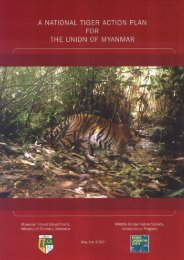Download - Global Tiger Initiative
Download - Global Tiger Initiative
Download - Global Tiger Initiative
You also want an ePaper? Increase the reach of your titles
YUMPU automatically turns print PDFs into web optimized ePapers that Google loves.
Kabul) (Chivers, 2002) and, in July 2002, an anonymous source informed TRAFFIC of a Snow<br />
Leopard skin on sale at a furrier’s shop in Kabul.<br />
Bhutan<br />
The main threats to Snow Leopards in Bhutan are considered to be retaliatory killings of Snow<br />
Leopards in response to livestock losses, and grazing competition between domestic livestock<br />
and Snow Leopard prey (mostly Blue Sheep). The loss of livestock represents a significant<br />
blow economically to local herders, as one adult yak is valued at around BTN12000 (USD252),<br />
the equivalent of 1.7 times the annual income of a wildlife ranger (D. Yonten, Nature<br />
Conservation Division, Department of Forestry of Bhutan, in litt., May 2003) (see Table 3).<br />
China<br />
The poaching of Snow Leopard prey species and habitat destruction, caused by over-grazing<br />
and human encroachment, are considered primary threats to Snow Leopards in western China<br />
(Ma et al., 2002). Conflicts between herders and Snow Leopards are reported to have occurred<br />
occasionally in China, sometimes resulting in the poisoning of the animal (R. Jackson, in litt.,<br />
12 July 2003). This type of conflict is widespread along the Tibetan border with Nepal, India<br />
and Bhutan, in the southern Xinjiang Autonomous Region, in Taxkoprgan Nature Reserve<br />
(along the Pakistani border), and in the Tien Shan mountains (R. Jackson, in litt., 12 July 2003).<br />
Trading of Snow Leopard parts obtained following the killing of an animal for livestock<br />
predation is not infrequent in the Tibet Autonomous Region (R. Jackson, in litt., 12 July 2003)<br />
and is said to be increasing in Xinjiang Autonomous Region (Wen, 2002).<br />
Trapping and killing for trade<br />
The poaching of Snow Leopards is considered to be one of the foremost threats to the cats in<br />
western China (Ma et al., 2002). According to official statistics, 60 of the animals were killed<br />
in Qinghai Province, in western China, between 1988 and 1995 and it is estimated that over 100<br />
have been poached in the province since 1990. It is assumed that the majority were killed by<br />
poachers that normally target Tibetan Antelopes Pantholops hodgsonii, but shoot Snow<br />
Leopards when an opportunity arises (Wen, 2002). In the neighbouring Xinjiang Autonomous<br />
Region, it is estimated that between 20 and 30 Snow Leopards are poached each year (Dai,<br />
2002).<br />
No comprehensive market surveys to assess the level of trade in Snow Leopard products have<br />
been undertaken in China but, as mentioned above, the trading of Snow Leopard parts following<br />
killings by herders may be on the rise in parts of China and this is reported to be in response to<br />
market demand, at least in Xinjiang Autonomous Region (Wen, 2002). One of the explanations<br />
for this may be an increased rate of detection, as a result of extra enforcement effort. The<br />
enforcement operation leading to the seizure of skins in Sichuan, in November 2001 (see over),<br />
involved more than 80 personnel from the Sichuan Forestry Department, the Sichuan Police<br />
Department and the Provincial Commerce Department, testimony to determined enforcement in<br />
that instance (J. Gong, Wildlife Conservation Division, Sichuan Forestry Department, in litt. to<br />
TRAFFIC East Asia, 2002). In any case, recent cases of Snow Leopard killings and trafficking<br />
in the animal’s body parts suggest that China is both source and market for the trade (see<br />
examples listed over).<br />
FADING FOOTPRINTS: the killing and trade of Snow Leopards 27

















